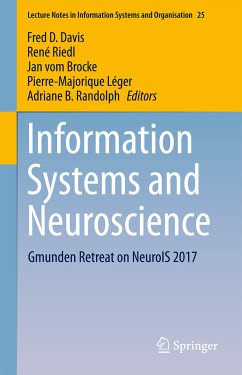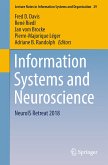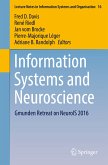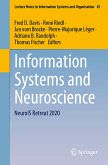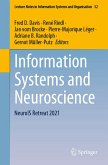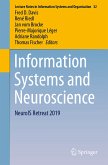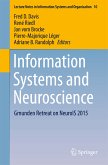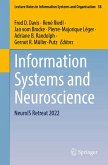Information Systems and Neuroscience (eBook, PDF)
Gmunden Retreat on NeuroIS 2017
Redaktion: Davis, Fred D.; Randolph, Adriane B.; Léger, Pierre-Majorique; Vom Brocke, Jan; Riedl, René
73,95 €
73,95 €
inkl. MwSt.
Sofort per Download lieferbar

37 °P sammeln
73,95 €
Als Download kaufen

73,95 €
inkl. MwSt.
Sofort per Download lieferbar

37 °P sammeln
Jetzt verschenken
Alle Infos zum eBook verschenken
73,95 €
inkl. MwSt.
Sofort per Download lieferbar
Alle Infos zum eBook verschenken

37 °P sammeln
Information Systems and Neuroscience (eBook, PDF)
Gmunden Retreat on NeuroIS 2017
Redaktion: Davis, Fred D.; Randolph, Adriane B.; Léger, Pierre-Majorique; Vom Brocke, Jan; Riedl, René
- Format: PDF
- Merkliste
- Auf die Merkliste
- Bewerten Bewerten
- Teilen
- Produkt teilen
- Produkterinnerung
- Produkterinnerung

Bitte loggen Sie sich zunächst in Ihr Kundenkonto ein oder registrieren Sie sich bei
bücher.de, um das eBook-Abo tolino select nutzen zu können.
Hier können Sie sich einloggen
Hier können Sie sich einloggen
Sie sind bereits eingeloggt. Klicken Sie auf 2. tolino select Abo, um fortzufahren.

Bitte loggen Sie sich zunächst in Ihr Kundenkonto ein oder registrieren Sie sich bei bücher.de, um das eBook-Abo tolino select nutzen zu können.
This book presents the proceedings of the Gmunden Retreat on NeuroIS 2017, reporting on topics at the intersection of Information Systems (IS) research, neurophysiology and the brain sciences. Readers will discover the latest findings from top scholars in the field of NeuroIS, which offer detailed insights on the neurobiology underlying IS behavior, essential methods and tools and their applications for IS, as well as the application of neuroscience and neurophysiological theories to advance IS theory.
- Geräte: PC
- ohne Kopierschutz
- eBook Hilfe
- Größe: 4.68MB
Andere Kunden interessierten sich auch für
![Information Systems and Neuroscience (eBook, PDF) Information Systems and Neuroscience (eBook, PDF)]() Information Systems and Neuroscience (eBook, PDF)73,95 €
Information Systems and Neuroscience (eBook, PDF)73,95 €![Information Systems and Neuroscience (eBook, PDF) Information Systems and Neuroscience (eBook, PDF)]() Information Systems and Neuroscience (eBook, PDF)73,95 €
Information Systems and Neuroscience (eBook, PDF)73,95 €![Information Systems and Neuroscience (eBook, PDF) Information Systems and Neuroscience (eBook, PDF)]() Information Systems and Neuroscience (eBook, PDF)73,95 €
Information Systems and Neuroscience (eBook, PDF)73,95 €![Information Systems and Neuroscience (eBook, PDF) Information Systems and Neuroscience (eBook, PDF)]() Information Systems and Neuroscience (eBook, PDF)105,95 €
Information Systems and Neuroscience (eBook, PDF)105,95 €![Information Systems and Neuroscience (eBook, PDF) Information Systems and Neuroscience (eBook, PDF)]() Information Systems and Neuroscience (eBook, PDF)73,95 €
Information Systems and Neuroscience (eBook, PDF)73,95 €![Information Systems and Neuroscience (eBook, PDF) Information Systems and Neuroscience (eBook, PDF)]() Information Systems and Neuroscience (eBook, PDF)40,95 €
Information Systems and Neuroscience (eBook, PDF)40,95 €![Information Systems and Neuroscience (eBook, PDF) Information Systems and Neuroscience (eBook, PDF)]() Information Systems and Neuroscience (eBook, PDF)129,95 €
Information Systems and Neuroscience (eBook, PDF)129,95 €-
-
-
This book presents the proceedings of the Gmunden Retreat on NeuroIS 2017, reporting on topics at the intersection of Information Systems (IS) research, neurophysiology and the brain sciences. Readers will discover the latest findings from top scholars in the field of NeuroIS, which offer detailed insights on the neurobiology underlying IS behavior, essential methods and tools and their applications for IS, as well as the application of neuroscience and neurophysiological theories to advance IS theory.
Dieser Download kann aus rechtlichen Gründen nur mit Rechnungsadresse in A, B, BG, CY, CZ, D, DK, EW, E, FIN, F, GR, HR, H, IRL, I, LT, L, LR, M, NL, PL, P, R, S, SLO, SK ausgeliefert werden.
Produktdetails
- Produktdetails
- Verlag: Springer International Publishing
- Seitenzahl: 218
- Erscheinungstermin: 16. November 2017
- Englisch
- ISBN-13: 9783319674315
- Artikelnr.: 52940808
- Verlag: Springer International Publishing
- Seitenzahl: 218
- Erscheinungstermin: 16. November 2017
- Englisch
- ISBN-13: 9783319674315
- Artikelnr.: 52940808
- Herstellerkennzeichnung Die Herstellerinformationen sind derzeit nicht verfügbar.
Fred D. Davis is Distinguished Professor and Bobby G. Stevenson Chair in Information Technology at Texas Tech University. René Riedl is a Professor for Digital Business and Innovation at the University of Applied Sciences Upper Austria and an Associate Professor for Business Informatics at the University of Linz. Jan vom Brocke is a Professor for Information Systems at the University of Liechtenstein, Hilti Chair of Business Process Management, and Director of the Institute of Information Systems. Pierre-Majorique Léger is a Professor in the Department of Information Technologies at HEC Montréal, Director of the ERPsim Lab and Co-director of the Tech3Lab. Adriane B. Randolph is an Associate Professor of Information Systems in the Michael J. Coles College of Business at Kennesaw State University (KSU) and Executive Director of the KSU BrainLab.
The Psychophysiological Effect of a Vibro-Kinetic Movie Experience: The Case of the D-BOX Movie Seat.- Reinforcement Sensitivity and Engagement in Proactive Recommendations: Experimental Evidence.- The Choice is Yours: The Role of Cognitive Processes for IT-Supported Idea Selection.- Blood Pressure Measurement: A Classic of Stress Measurement and its Role in Technostress Research.- On the Role of Users' Cognitive-Affective States for User Assistance Invocation.- Measuring and Explaining Cognitive Load During Design Activities: A fine-grained approach.- How Product Decision Characteristics Interact to Influence Cognitive Load: An Exploratory Study.- Wh
y and How to Design Complementary NeuroIS and Behavioral Experiments.- The Impact of Age and Cognitive Style on E-Commerce Decisions: The Role of Cognitive Bias Susceptibility.- Expertise as a Mediating Factor in Conceptual Modeling.- A Neuro-Cognitive Explanation for the Prevalence of Folder Navigation and Web Browsing.- Physiological, Psychological, and Behavioral Measures in the Study of IS Phenomena: A Theoretical Analysis of Triangulation Strategies.- The psychophysiology of flow: A systematic review of peripheral nervous system features.- Predicting properties of cognitive pupillometry in human computer interaction: A preliminary investigation.- Human vs. Machine: Contingency Factors of Anthropomorphism as a Trust-Inducing Design Strategy for Conversational Agents.- Affective processing guides behavior and emotions communicate feelings.- Shifting the System to the Real World: Can mobile fNIRS add to NeuroIS?.- Decision Inertia and Arousal: Using NeuroIS to Analyze Bio-Physiological Antecedents of Decision Inertia in a Dual Choice Paradigm.- IAT Measurement Method to Evaluate Emotional Aspects of Brand Perception - a Pilot Study.- Inferring Web Page Relevance using Pupillometry and One-channel EEG.- Measuring Biosignals of Overweight and Obese Children for Real-time Feedback and Predicting Performance.- Stationarity of a user's pupil size signal as a precondition of pupillary-based mental workload evaluation.- Towards Reconceptualizing the Core of the IS Field from a Neurobiological Perspective.- Using EEG Signal to Analyze Decision Making Cognitive Processes.
y and How to Design Complementary NeuroIS and Behavioral Experiments.- The Impact of Age and Cognitive Style on E-Commerce Decisions: The Role of Cognitive Bias Susceptibility.- Expertise as a Mediating Factor in Conceptual Modeling.- A Neuro-Cognitive Explanation for the Prevalence of Folder Navigation and Web Browsing.- Physiological, Psychological, and Behavioral Measures in the Study of IS Phenomena: A Theoretical Analysis of Triangulation Strategies.- The psychophysiology of flow: A systematic review of peripheral nervous system features.- Predicting properties of cognitive pupillometry in human computer interaction: A preliminary investigation.- Human vs. Machine: Contingency Factors of Anthropomorphism as a Trust-Inducing Design Strategy for Conversational Agents.- Affective processing guides behavior and emotions communicate feelings.- Shifting the System to the Real World: Can mobile fNIRS add to NeuroIS?.- Decision Inertia and Arousal: Using NeuroIS to Analyze Bio-Physiological Antecedents of Decision Inertia in a Dual Choice Paradigm.- IAT Measurement Method to Evaluate Emotional Aspects of Brand Perception - a Pilot Study.- Inferring Web Page Relevance using Pupillometry and One-channel EEG.- Measuring Biosignals of Overweight and Obese Children for Real-time Feedback and Predicting Performance.- Stationarity of a user's pupil size signal as a precondition of pupillary-based mental workload evaluation.- Towards Reconceptualizing the Core of the IS Field from a Neurobiological Perspective.- Using EEG Signal to Analyze Decision Making Cognitive Processes.
The Psychophysiological Effect of a Vibro-Kinetic Movie Experience: The Case of the D-BOX Movie Seat.- Reinforcement Sensitivity and Engagement in Proactive Recommendations: Experimental Evidence.- The Choice is Yours: The Role of Cognitive Processes for IT-Supported Idea Selection.- Blood Pressure Measurement: A Classic of Stress Measurement and its Role in Technostress Research.- On the Role of Users' Cognitive-Affective States for User Assistance Invocation.- Measuring and Explaining Cognitive Load During Design Activities: A fine-grained approach.- How Product Decision Characteristics Interact to Influence Cognitive Load: An Exploratory Study.- Wh
y and How to Design Complementary NeuroIS and Behavioral Experiments.- The Impact of Age and Cognitive Style on E-Commerce Decisions: The Role of Cognitive Bias Susceptibility.- Expertise as a Mediating Factor in Conceptual Modeling.- A Neuro-Cognitive Explanation for the Prevalence of Folder Navigation and Web Browsing.- Physiological, Psychological, and Behavioral Measures in the Study of IS Phenomena: A Theoretical Analysis of Triangulation Strategies.- The psychophysiology of flow: A systematic review of peripheral nervous system features.- Predicting properties of cognitive pupillometry in human computer interaction: A preliminary investigation.- Human vs. Machine: Contingency Factors of Anthropomorphism as a Trust-Inducing Design Strategy for Conversational Agents.- Affective processing guides behavior and emotions communicate feelings.- Shifting the System to the Real World: Can mobile fNIRS add to NeuroIS?.- Decision Inertia and Arousal: Using NeuroIS to Analyze Bio-Physiological Antecedents of Decision Inertia in a Dual Choice Paradigm.- IAT Measurement Method to Evaluate Emotional Aspects of Brand Perception - a Pilot Study.- Inferring Web Page Relevance using Pupillometry and One-channel EEG.- Measuring Biosignals of Overweight and Obese Children for Real-time Feedback and Predicting Performance.- Stationarity of a user's pupil size signal as a precondition of pupillary-based mental workload evaluation.- Towards Reconceptualizing the Core of the IS Field from a Neurobiological Perspective.- Using EEG Signal to Analyze Decision Making Cognitive Processes.
y and How to Design Complementary NeuroIS and Behavioral Experiments.- The Impact of Age and Cognitive Style on E-Commerce Decisions: The Role of Cognitive Bias Susceptibility.- Expertise as a Mediating Factor in Conceptual Modeling.- A Neuro-Cognitive Explanation for the Prevalence of Folder Navigation and Web Browsing.- Physiological, Psychological, and Behavioral Measures in the Study of IS Phenomena: A Theoretical Analysis of Triangulation Strategies.- The psychophysiology of flow: A systematic review of peripheral nervous system features.- Predicting properties of cognitive pupillometry in human computer interaction: A preliminary investigation.- Human vs. Machine: Contingency Factors of Anthropomorphism as a Trust-Inducing Design Strategy for Conversational Agents.- Affective processing guides behavior and emotions communicate feelings.- Shifting the System to the Real World: Can mobile fNIRS add to NeuroIS?.- Decision Inertia and Arousal: Using NeuroIS to Analyze Bio-Physiological Antecedents of Decision Inertia in a Dual Choice Paradigm.- IAT Measurement Method to Evaluate Emotional Aspects of Brand Perception - a Pilot Study.- Inferring Web Page Relevance using Pupillometry and One-channel EEG.- Measuring Biosignals of Overweight and Obese Children for Real-time Feedback and Predicting Performance.- Stationarity of a user's pupil size signal as a precondition of pupillary-based mental workload evaluation.- Towards Reconceptualizing the Core of the IS Field from a Neurobiological Perspective.- Using EEG Signal to Analyze Decision Making Cognitive Processes.
